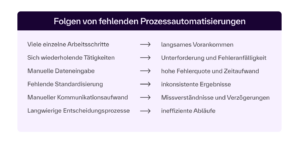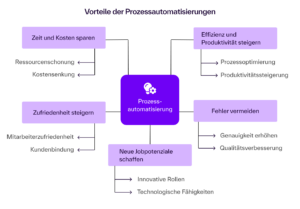What exactly is process automation and how does it affect the world of work? We reveal where process automation makes sense, what it means for skilled workers and which skills are now more in demand than ever before.
The most important facts in brief
- Process automation means that standardized workflows that were previously performed manually are carried out by automated programs, robots (RPA) or AI tools.
- Process automation is not only necessary in the manufacturing industry, but also in all other companies and business areas in order to ensure competitiveness.
- Process automation creates new fields of activity and requires specialist skills in order to implement and manage them successfully.
Definition: What is process automation?
Process automation is the use of technologies to perform recurring, rule-based tasks or processes with minimal or no human intervention. The aim is to make manual processes more efficient, faster, cheaper and error-free.
When processes in a company are automated, this means that certain work steps no longer need to be carried out or controlled by people. Instead, the tasks can be transferred to automated workflows, for example. Depending on which work steps are automated, a digital robot or an AI tool takes over the tasks that were previously carried out manually.
Difference between process automation and process optimization
Process automation is a specific method of process optimization that aims to automate individual process flows. Process optimization includes all steps that are taken to improve the workflows in an organization.
What types of process automation are there?
Depending on the area in which process automation takes place, a distinction is made between different approaches. The overarching term Business Process Automation (BPA) covers all forms of automation that aim to make business processes more efficient, faster and error-free
There are specific methods within BPA, including Robotic Process Automation (RPA), IT Process Automation (ITPA) and API-based automation.
- Robotic process automation (RPA) automates rule-based, repetitive tasks, especially when processing structured data. Examples include filling out forms, transferring data between systems or generating standard reports. RPA uses software robots that mimic human interactions with user interfaces.
- IT Process Automation (ITPA) refers to the automation of IT-related processes, primarily in system administration, security and network monitoring. Examples include automated backups, patch management, error detection and correction as well as security checks. This automation reduces manual effort in IT departments and helps to proactively minimize risks.
- API-based automation is direct, code-based automation in which systems communicate with each other via application programming interfaces (APIs) without the need to simulate a user interface. Compared to RPA, API automation is often more stable, faster and less error-prone as it integrates directly into the system architecture. It is often used for data transfers between applications, the synchronization of customer data or automated ordering processes.
While RPA and ITPA cover specific areas within BPA, API automation is a complementary or alternative method for making processes more efficient. Companies can combine different approaches to find the optimal automation solution depending on the use case.
Where can processes be automated?
Process automation is ideal for repetitive workflows that require a high level of concentration but are not necessarily intellectually demanding. While robots are primarily used for this in the manufacturing industry, many work tasks can also be automated in administrative areas of the company.
| Department | Processes that can be automated |
|---|---|
| Finance | - Creating and sending payment reminders - Importing and posting incoming invoices - Creating financial reports and analyses |
| IT | - Creation of user accounts and assignment of authorizations based on predefined roles - Monitoring of IT systems with notification of problems - Creation and management of data backups to ensure data integrity |
| HR | - Sending invitations to training and orientation events for new Employees - Collecting and analyzing employee feedback to improve the working environment - Pre-selection of applications based on defined criteria - Automated onboarding of new Employees |
| Product management | - Collecting and evaluating product data to generate reports - Analyzing market data to identify trends and opportunities |
| Customer Service | - Forwarding customer inquiries to the appropriate team members based on inquiry categories - Sending standardized answers to frequently asked questions - Chatbots to answer common questions around the clock |
| Purchasing and logistics | - Processing of orders from receipt to delivery - Monitoring of stock levels with reordering if stock falls below a threshold value |
| Marketing | - Sending personalized emails to target groups based on their behavior and preferences - Scheduling and publishing posts on various social media platforms |
| Distribution | - Evaluation of potential target groups based on their interactions and characteristics - Automated lead scoring systems for evaluating customer potential - Generate offers based on predefined templates and pricing models |
| Administration | - Coordination of appointments based on the availability of those involved - Storage and management of documents with corresponding access control |
Process automation means that even extensive tasks can be handled efficiently and error-free without requiring the working time of a trained specialist.
How to define processes that are well suited to automation
Work steps that are particularly suitable for process automation:
- are repeated regularly,
- Sales representatives: Work without a fixed location, as they visit various customers .
- always remain the same in terms of content,
- are carried out according to certain standards and occur frequently or in large volumes.
The more rule-based and repetitive the process, the easier it is to automate.
Successful use cases of process automation
Process automation is already being used in numerous business areas. For example, insurance companies are successfully using generative models that can automatically extract all relevant information from incoming invoices, thereby completely digitizing the claims recording process.
Even universities that comprise several departments have already been able to significantly reduce their time expenditure and minimize inefficient work steps through process automation. For example, processes for processing training applications and reimbursements can be automated.

Your guide to successful business automation
To remain competitive, organizations need to work more efficiently, faster and smarter. Business automation helps them do just that and frees up time for the essentials. In this guide, you will find out how business automation works in practice - with a clear process, specific use cases and helpful tips.
Download free of charge
Why process automation is important
Process automation enables organizations and companies to carry out necessary but less demanding tasks effectively in a short time. This is particularly relevant for work steps that require a high level of concentration. By automating these processes, Employees can use their resources for more demanding tasks.

5 major advantages of process automation
Without automated processes, companies and organizations find it increasingly difficult to remain competitive. The following advantages speak in favor of the targeted transfer of individual processes to an automated solution.
1. time and costs are saved
Administrative processes in particular often take up a lot of time in companies. Many work steps can be saved through automation - be it through data that no longer needs to be maintained manually or pay slips that no longer need to be printed out and sent by post.
2. efficiency and productivity increase
Robots or AI tools do not tire and generally carry out the work steps faster and more precisely. Unnecessary work steps are avoided and larger amounts of information can be processed. Robots and programs that can continue working outside of regular working hours are particularly relevant here.
3. errors are avoided
Monotonous and repetitive tasks in particular harbor a certain potential for error. Automation prevents errors due to lack of concentration or fatigue.
4. satisfaction increases
Dull, repetitive tasks no longer have to be carried out by Employees . They can now use their specialist skills for more demanding tasks instead.
At the same time, intelligent tools such as chatbots reduce the workload of the team and increase customer satisfaction, especially in customer service: customers receive answers to most of their questions in real time, even outside regular opening hours.
5. new job potentials arise
Contrary to concerns that process automation would lead to job losses, this development in turn creates a need for new specialist skills. The shortage of skilled workers is here to stay and there are numerous new opportunities for Employees to develop their potential within the company. What actually disappears are the often unpleasant tasks that nobody usually likes to take on.

What challenges does process automation entail?
Despite the numerous advantages of process automation, companies and organizations often face major challenges at the beginning. Especially at the beginning, high implementation costs can be an obstacle. In addition, employees are often concerned that automation will replace them as workers.
Depending on the complexity and number of interfaces, additional problems can arise if communication is not transparent and timely. Structured change management therefore forms the basis for process automation : experts are needed who provide professional support for developments from the outset.

Take an active part in shaping the future of your company!
Become an expert in intelligent automation and proactively drive important innovations in your company. In our Future Jobs Class, you will learn how to identify and implement the right technological solutions for relevant areas in your company. Your future starts right ... now!
Become a Business Automation Manager now
Process automation - what's next?
Automated processes will fundamentally change the world of work. The combination of different technologies will become just as relevant as tools that can be operated without programming skills and work across platforms.
Hyperautomation
Hyperautomation is the comprehensive automation of business and IT processes through the combination of various technologies such as RPA, AI and low-code/no-code platforms. Typical use cases include the automation of customer service, financial processes, HR tasks and IT support. By intelligently networking these technologies, hyperautomation enables seamless, self-learning process optimization.
RPA and AI
The combination of RPA and AI in particular has the potential to fundamentally revolutionize numerous areas of work. While RPA has so far primarily taken over standardized work steps without major variations, the integration of AI will make it possible to transfer far more complex tasks in the future.
Low-code/no-code automation
Low-code/no-code automation enables companies to automate business processes and IT workflows with minimal or no programming effort. Visual development environments with drag-and-drop functions, predefined modules and intuitive interfaces are used so that even non-programmers (so-called citizen developers) can create automations.
- Low-code: Requires little manual coding, but enables customizations for complex automations. Ideal for technically experienced user:in.
- No-code: Can be used completely without programming knowledge. No-Code is therefore suitable for business users who want to automate processes quicklyuser:in
An important modeling language in relation to the low-code/no-code method is BPMN 2.0 (Business Process Model and Notation). BPMN 2.0 graphically represents business processes in such a way that they can be read by both humans and software (workflow engines).
The working world of tomorrow therefore needs qualified experts, such as business automation managers, who not only have an understanding of these tools, but can also effectively combine their potential.
Frequently asked questions about process automation
When does automation make sense?
Automation makes sense when work processes are repeated regularly, always follow a certain pattern and take a lot of time. While automated workflows, robots or AI tools process the tasks independently of time and without errors, human workers can concentrate on their actual specialist skills.
What is the difference between automation and AI?
Automation is generally understood to mean the automatic execution of certain work processes. This does not always require AI, as robots (RPA) or digital tools are often used for automated workflows. AI is used when more complex issues are dealt with and a differentiated approach is required.
Will people be replaced by process automation?
A common concern about process automation is that it will eventually replace human labor entirely. In reality, however, human specialists are now more important than ever: they take on key roles, make decisions and provide technical expertise without having to waste valuable time on dull tasks.
What specific skills are needed for process automation?
In order to be able to integrate process automation holistically, specialists need both analytical skills and a basic understanding of technologies and digital tools. Process automation is also always part of a change process, which means that change management expertise is also required.




